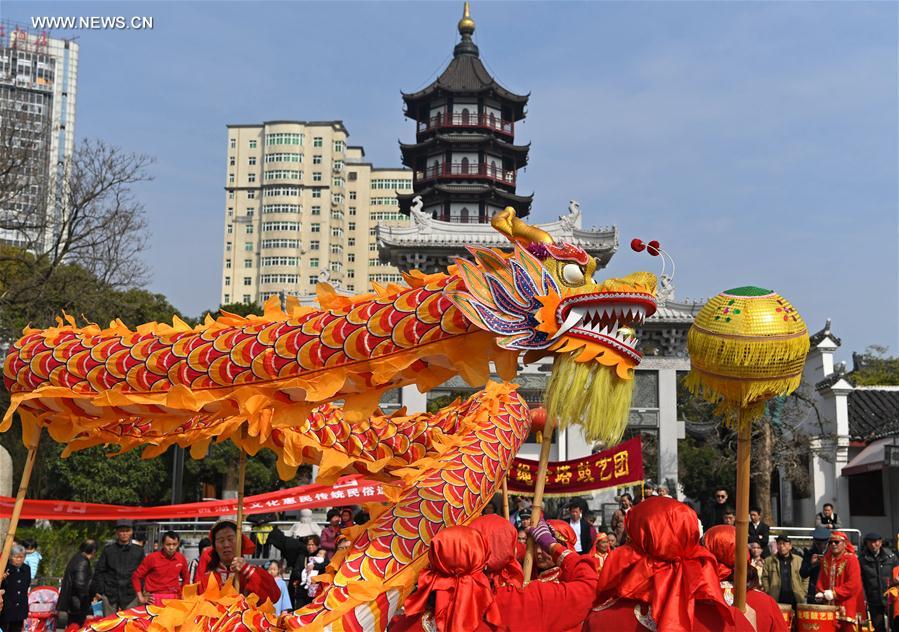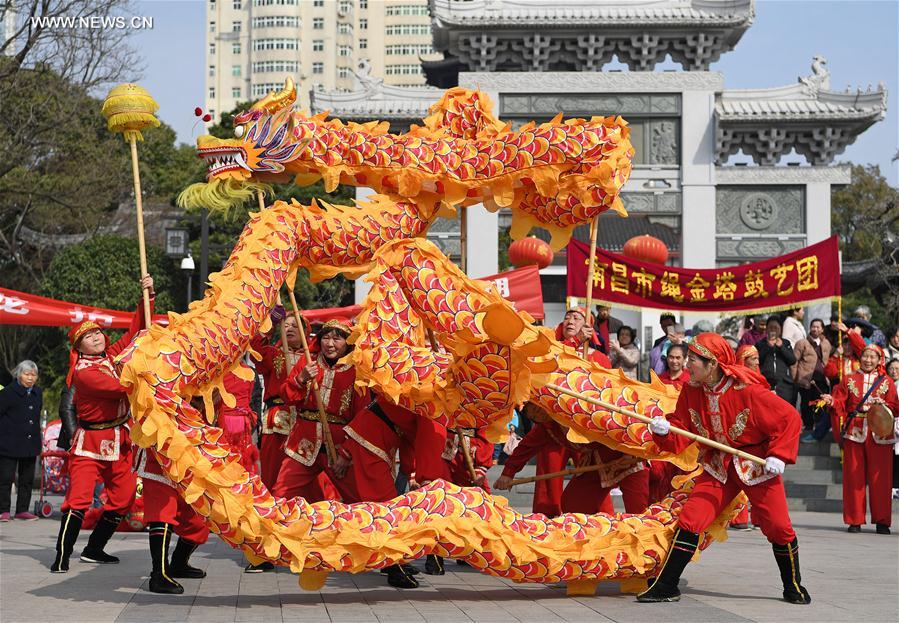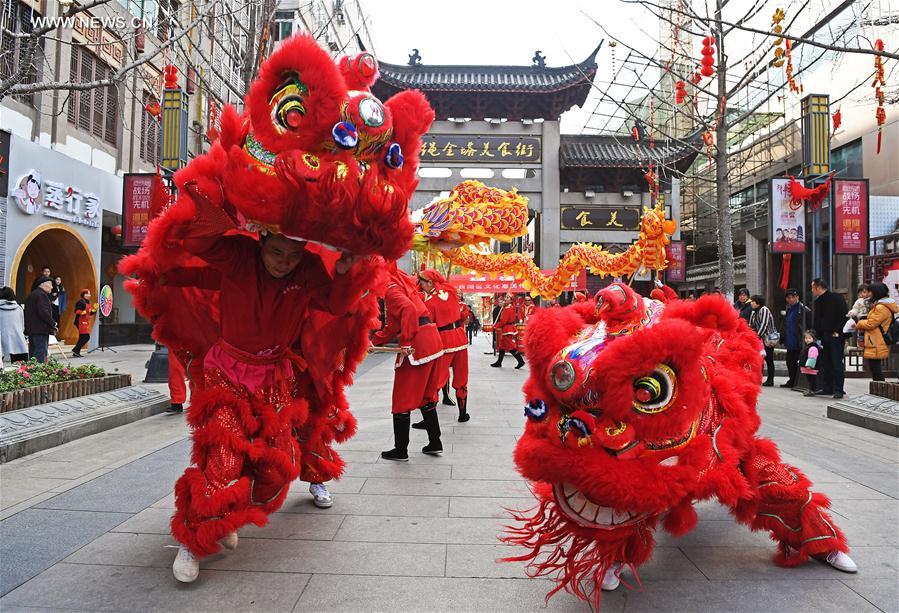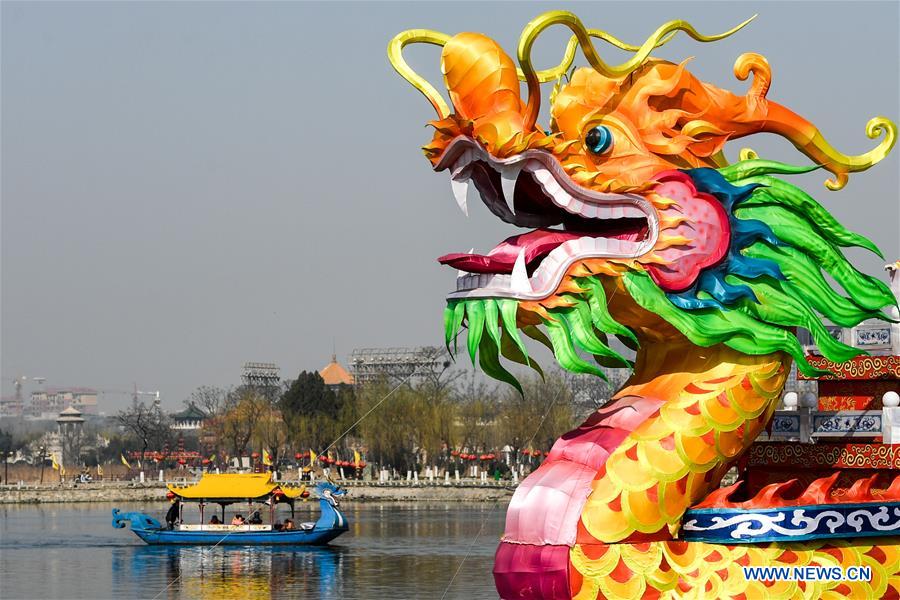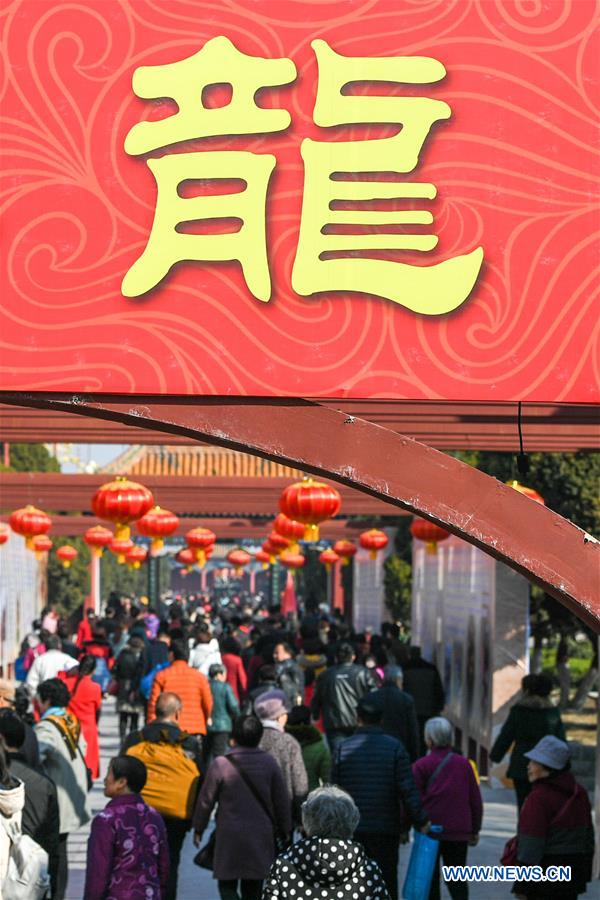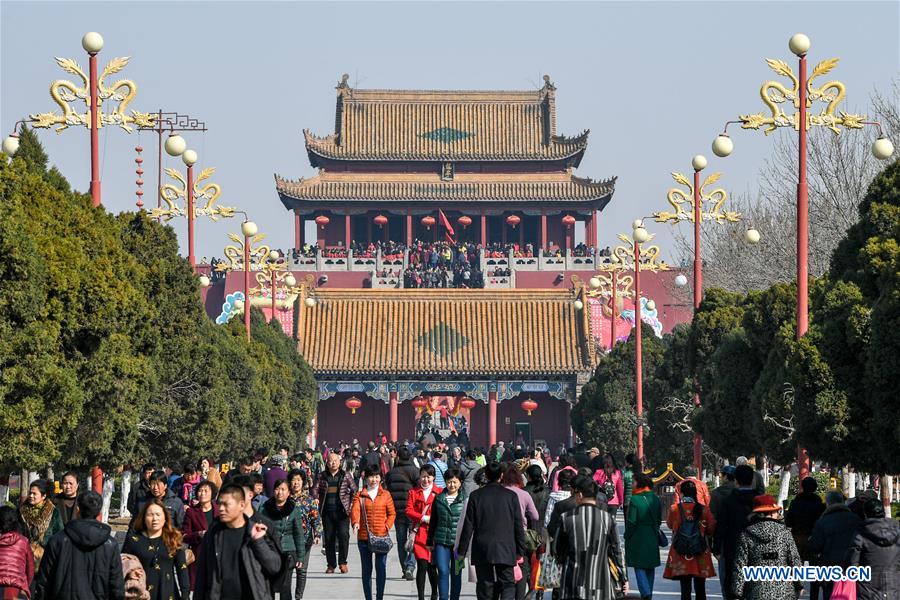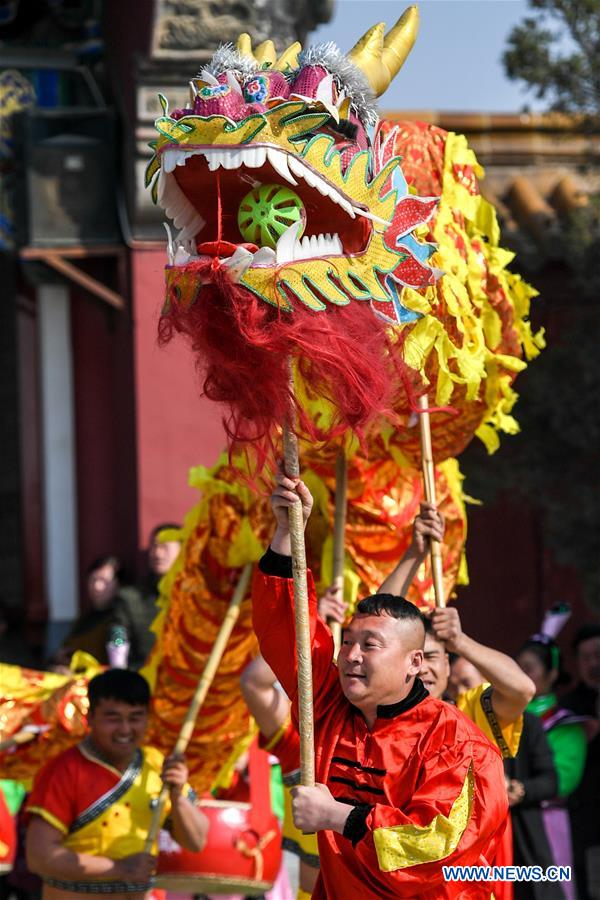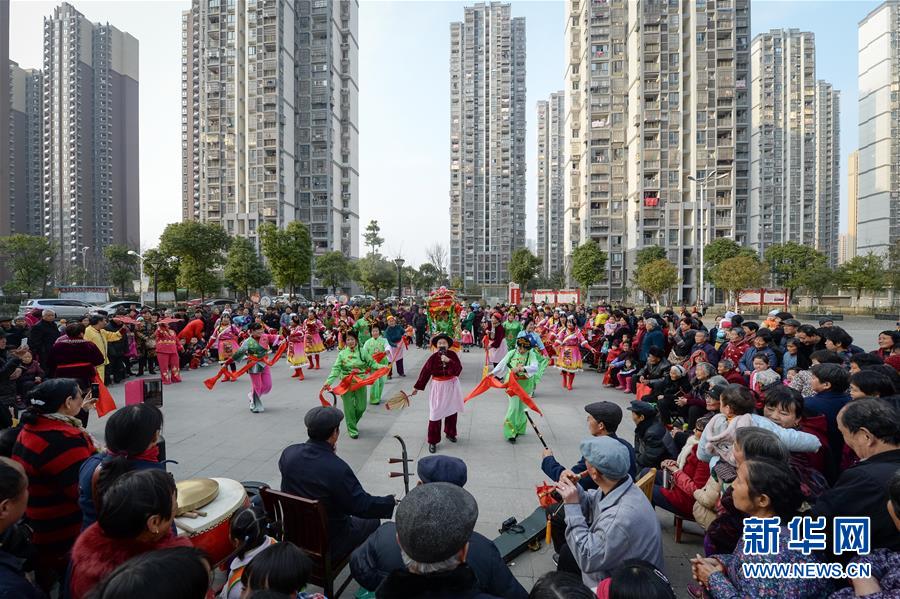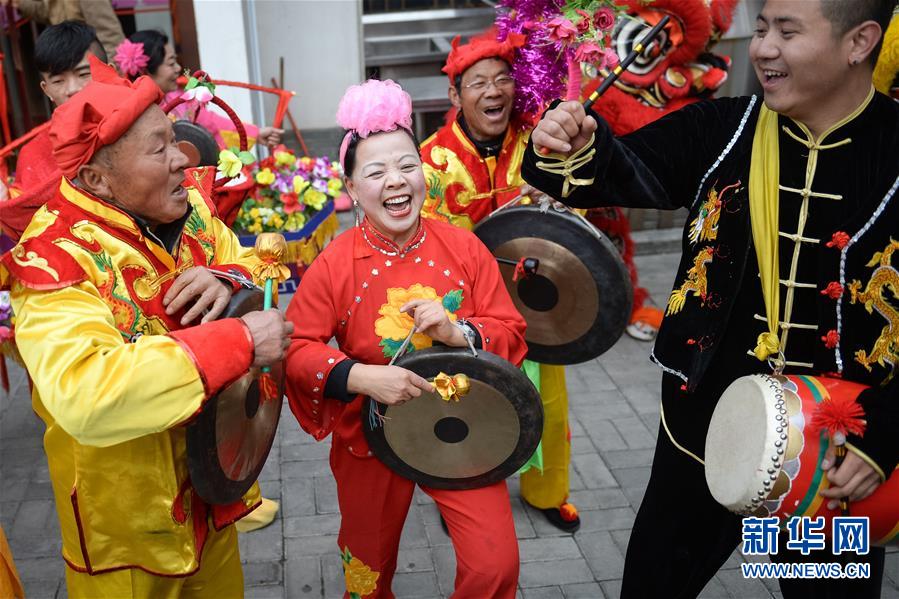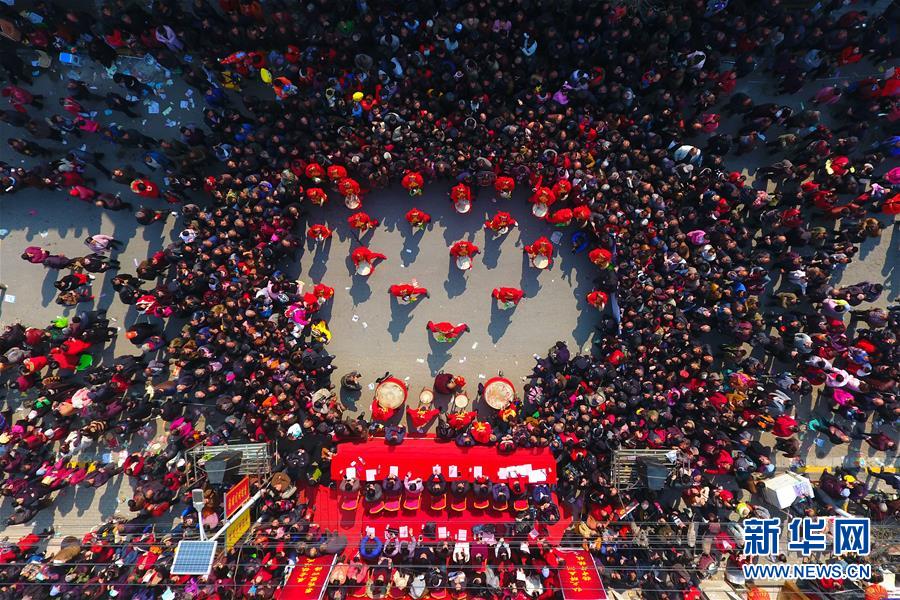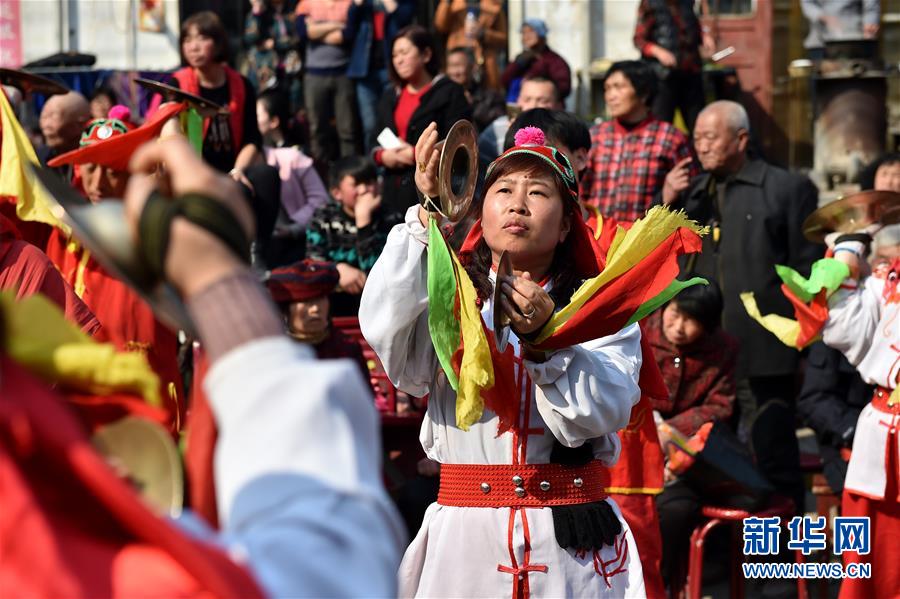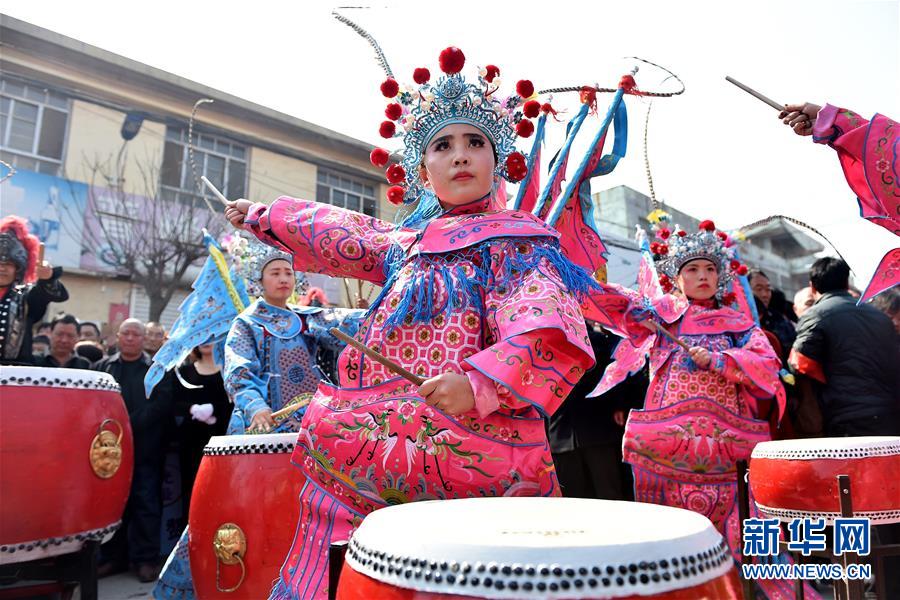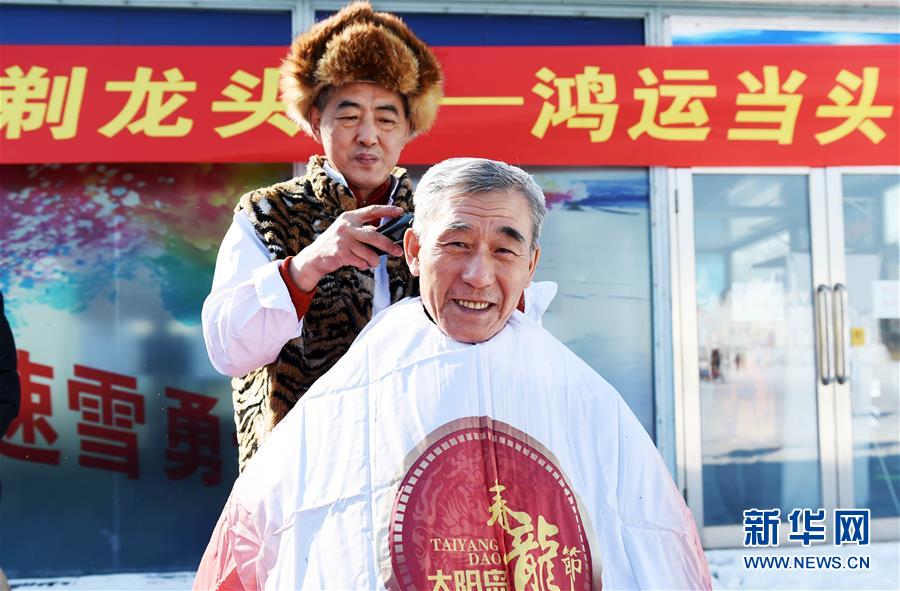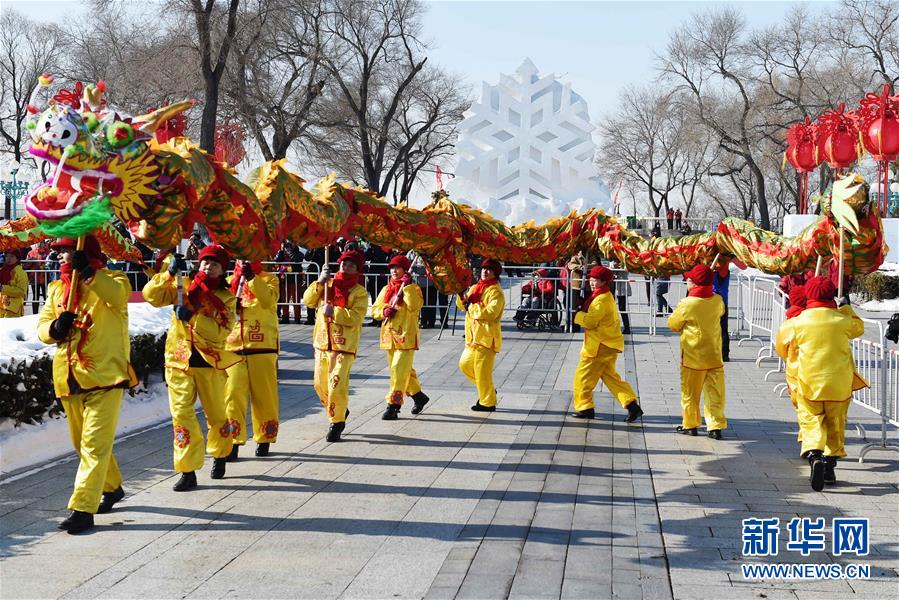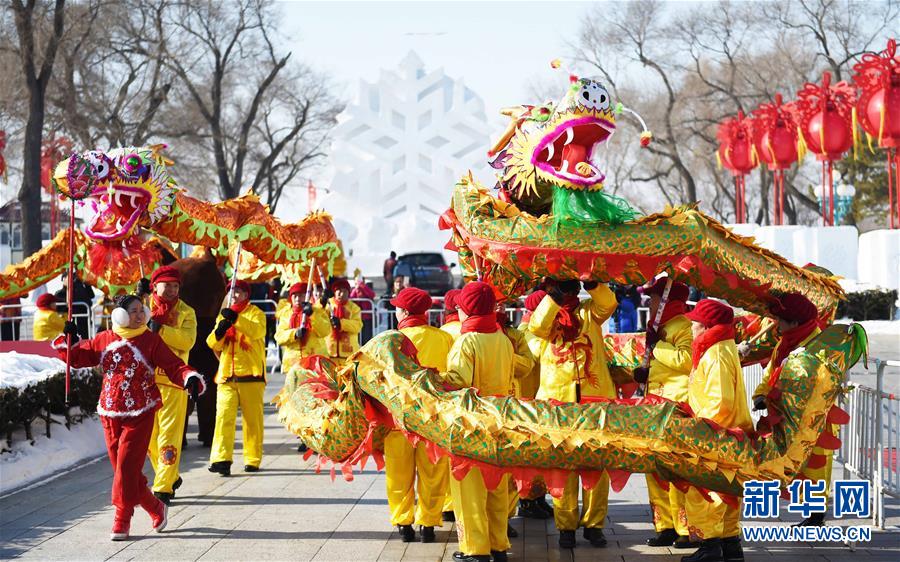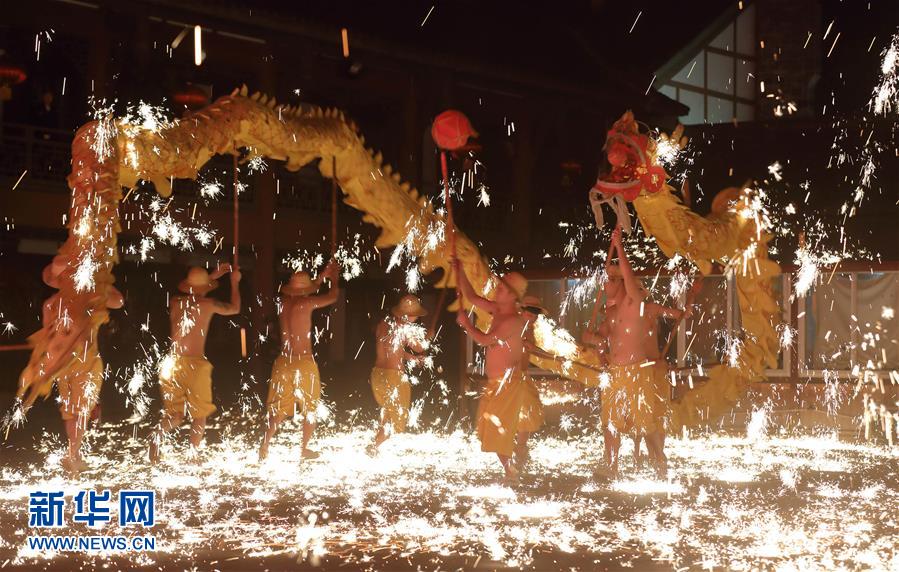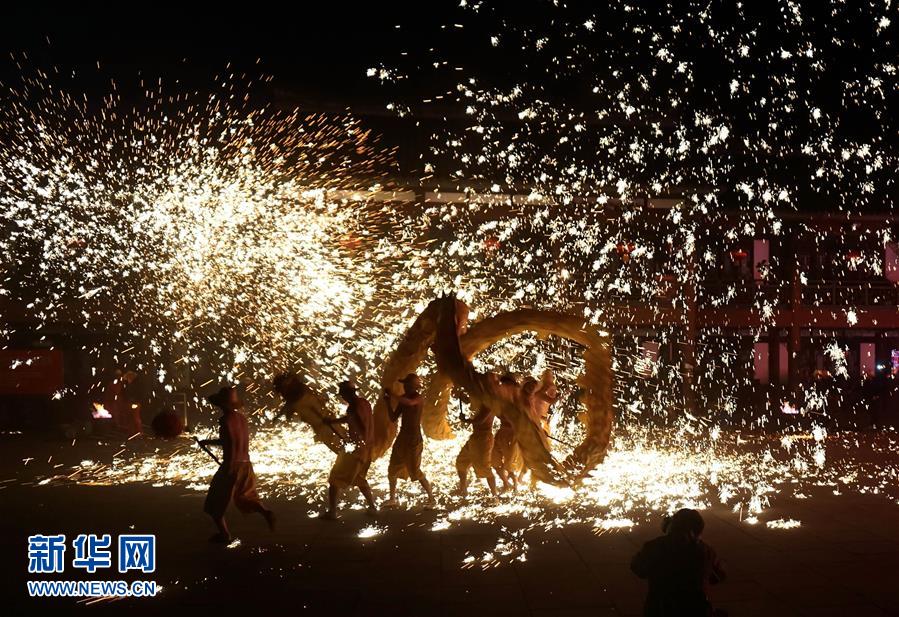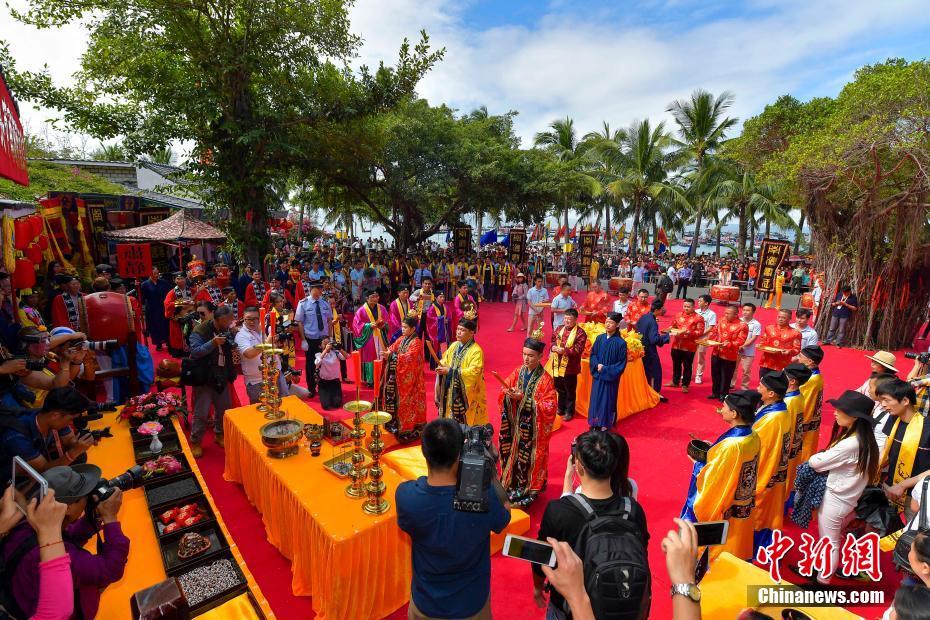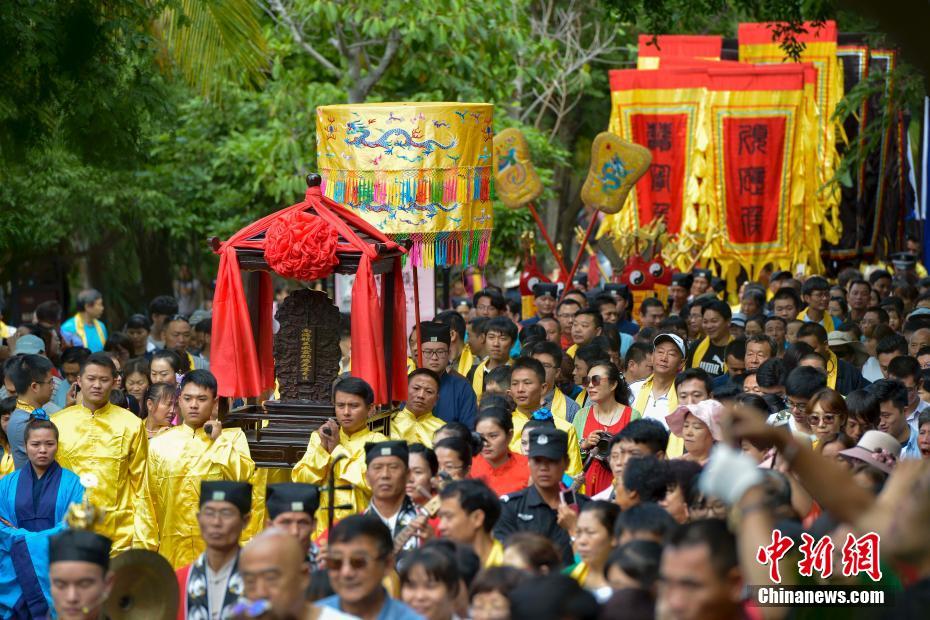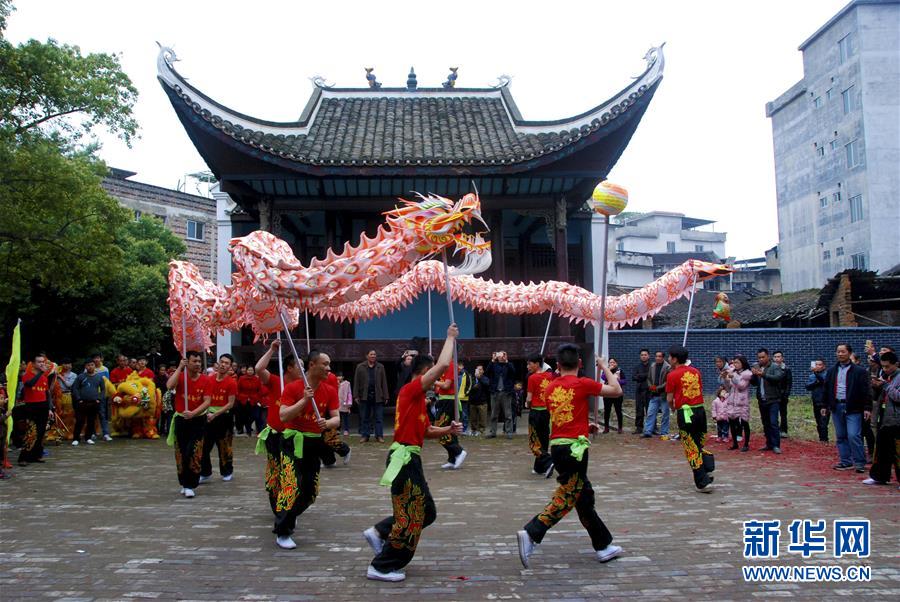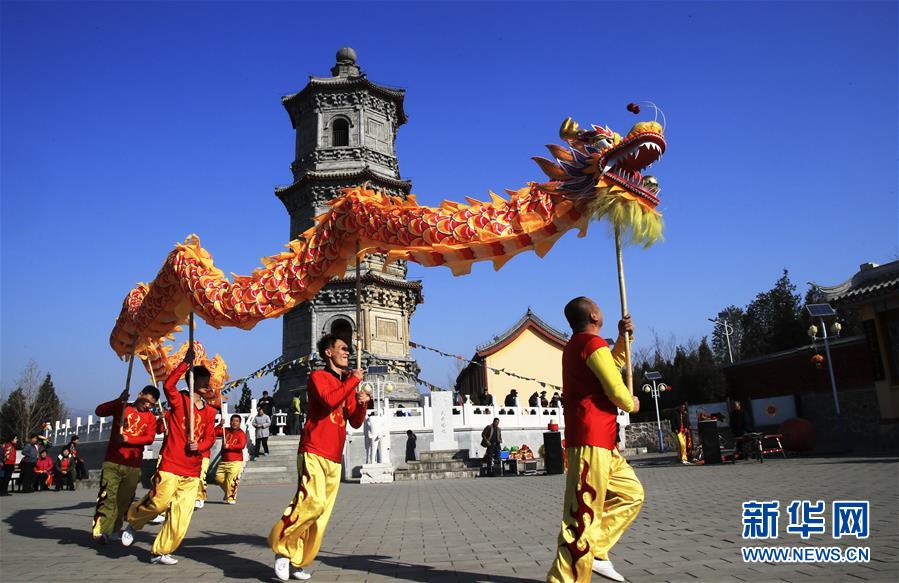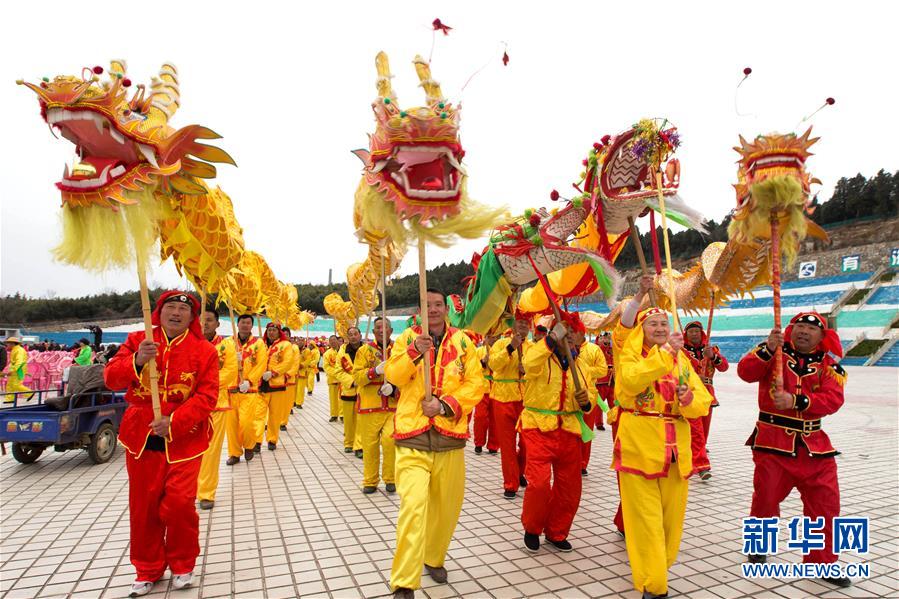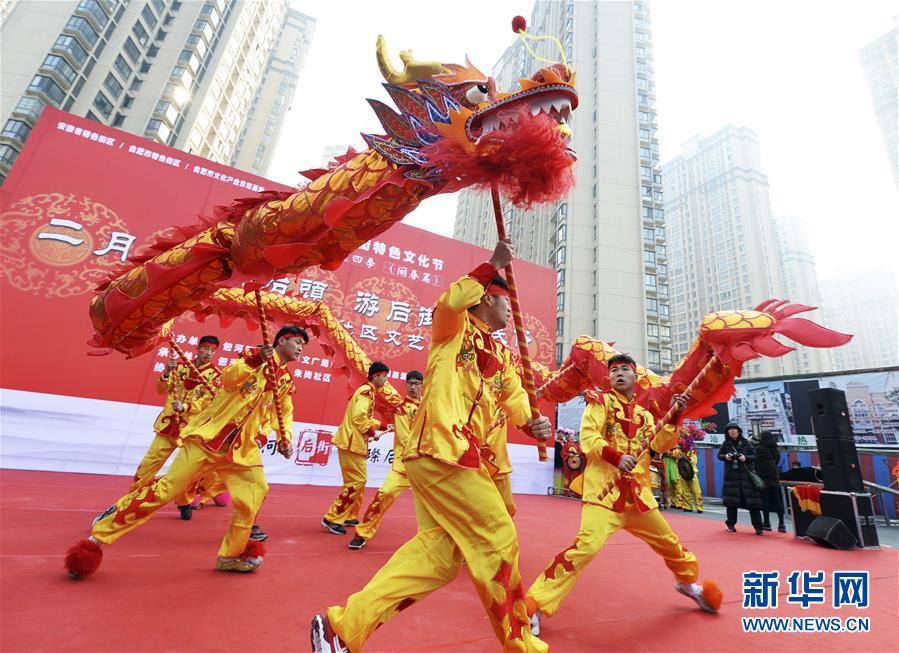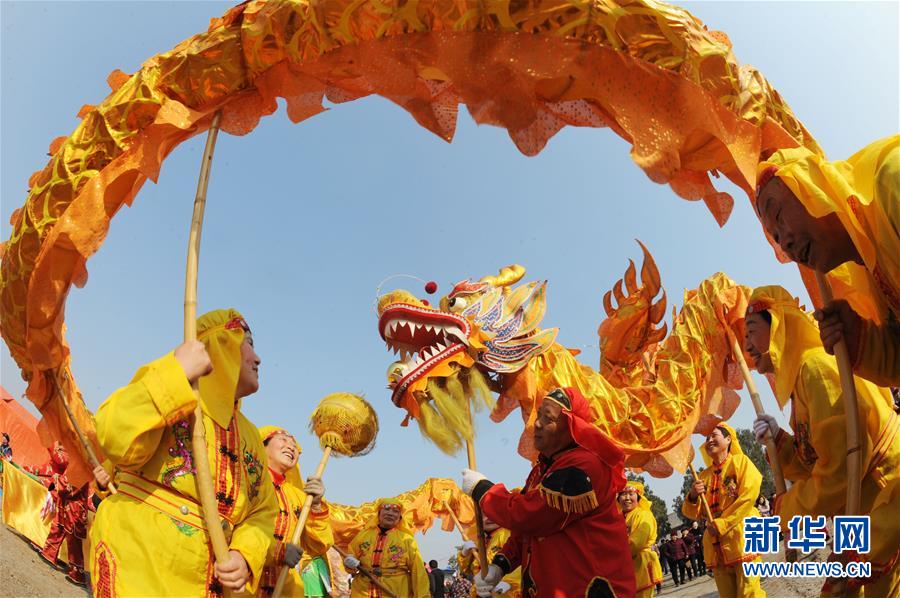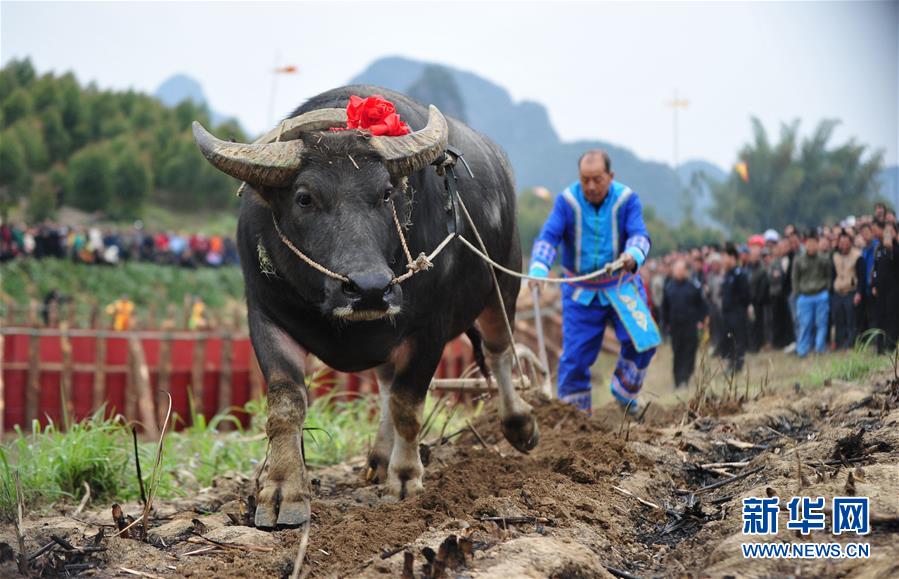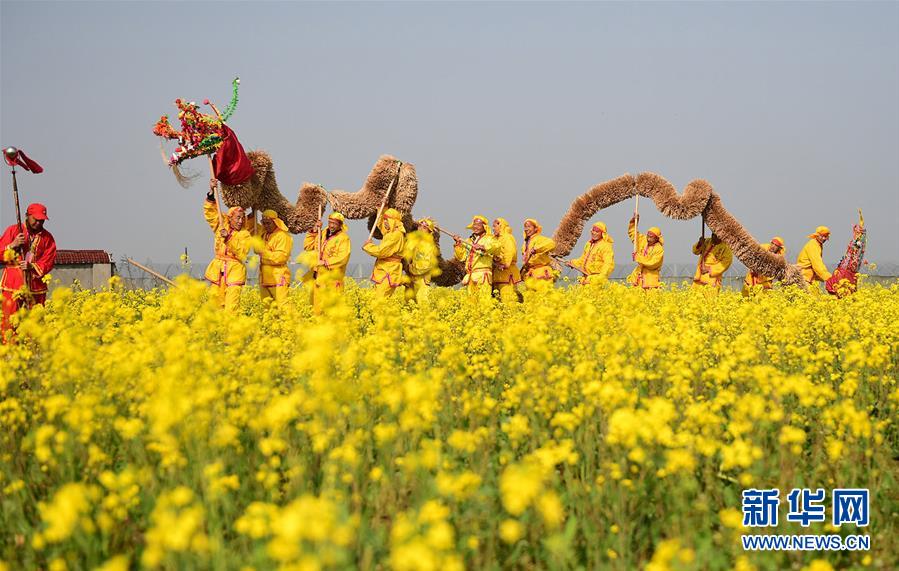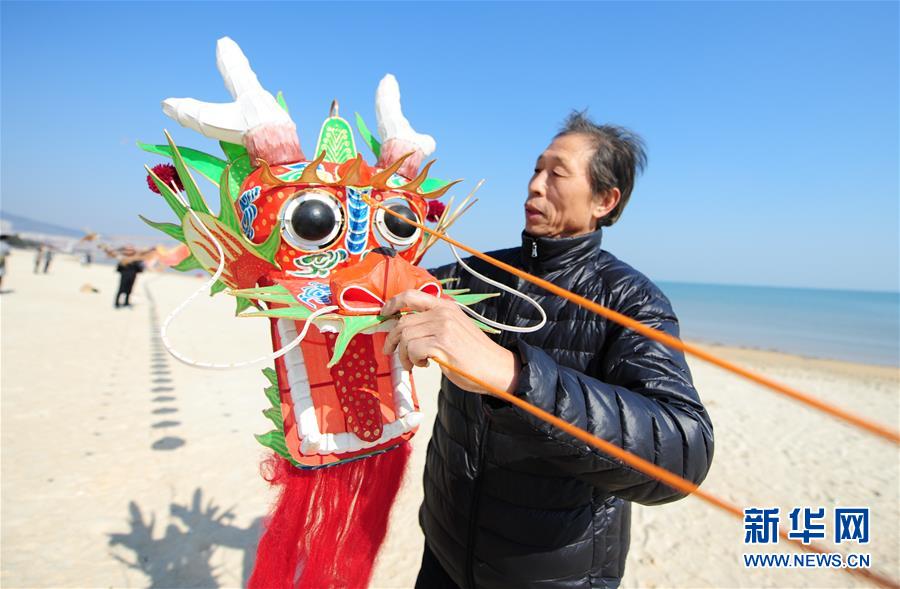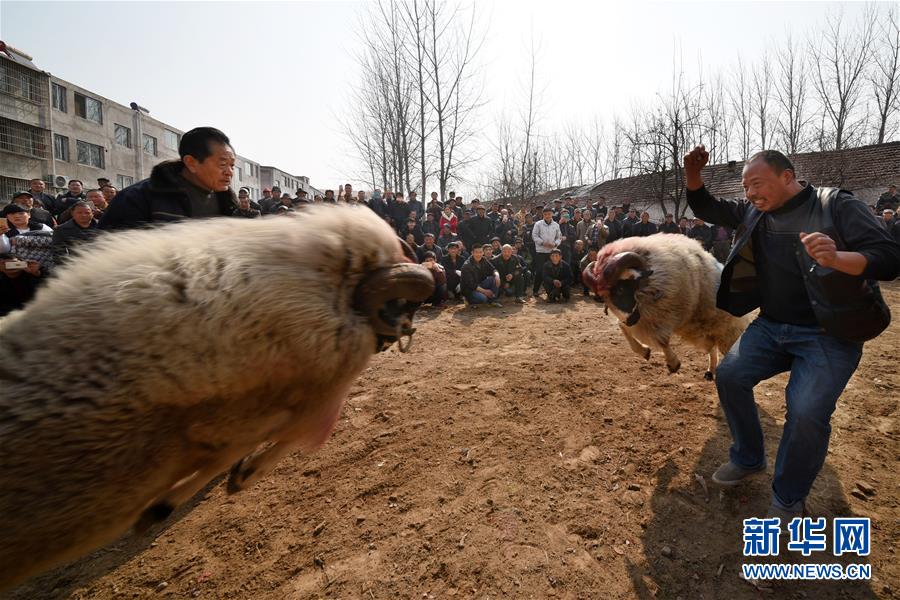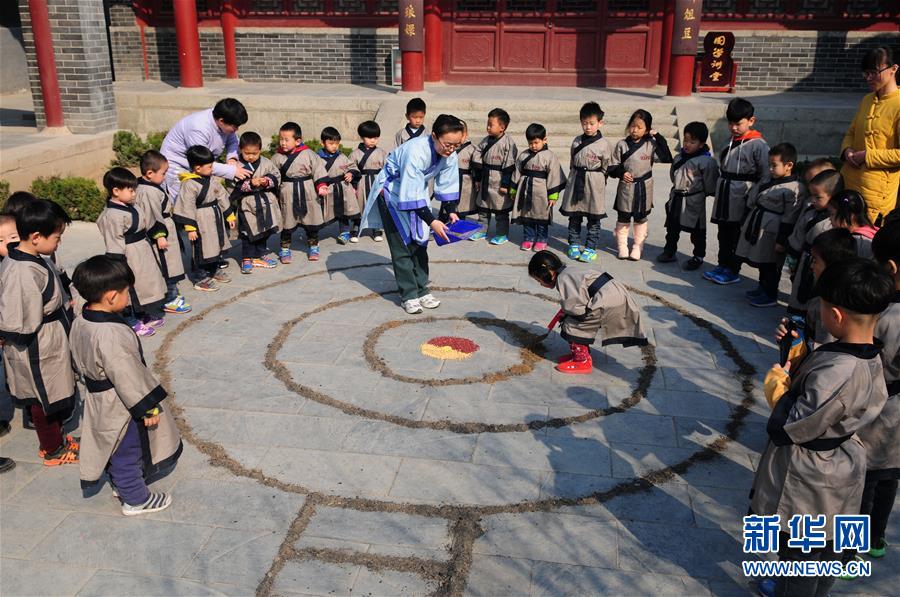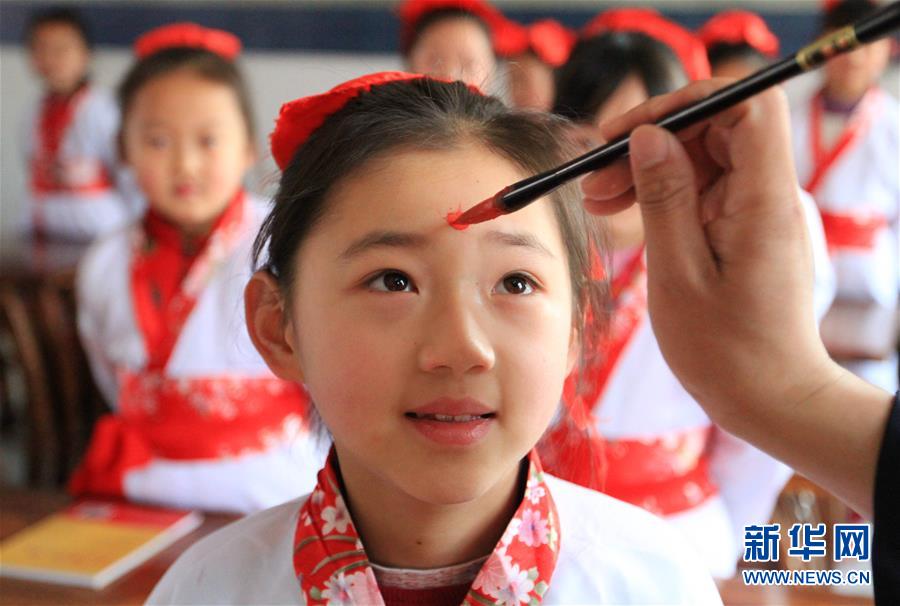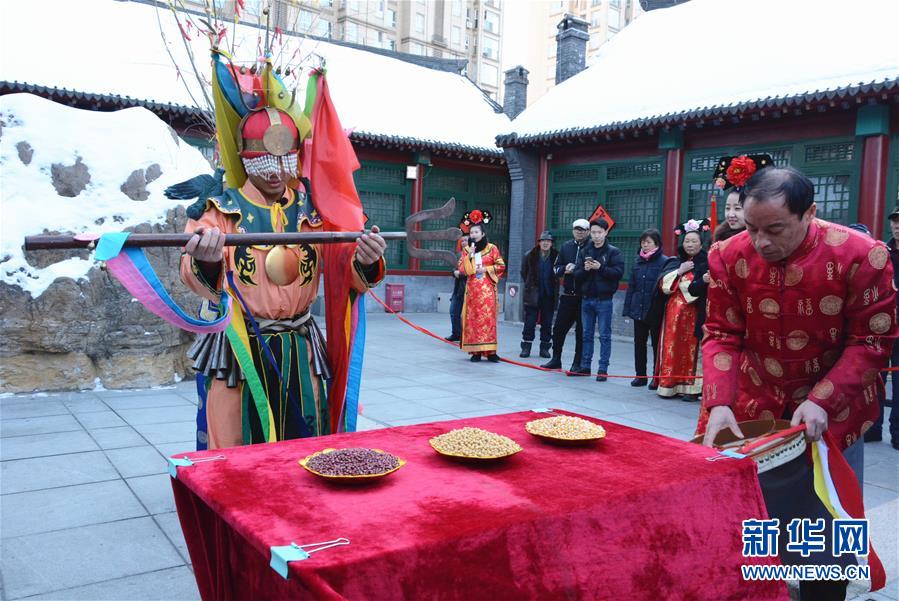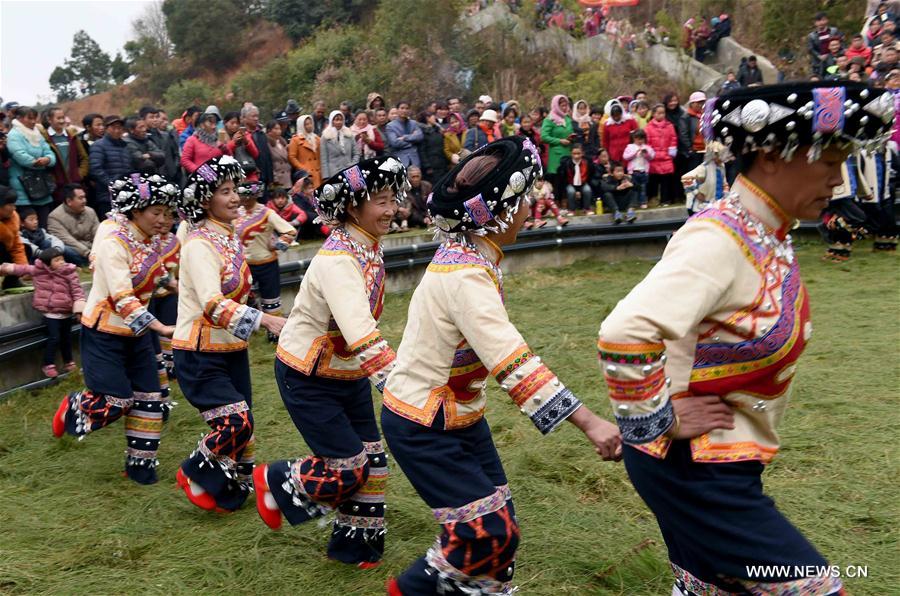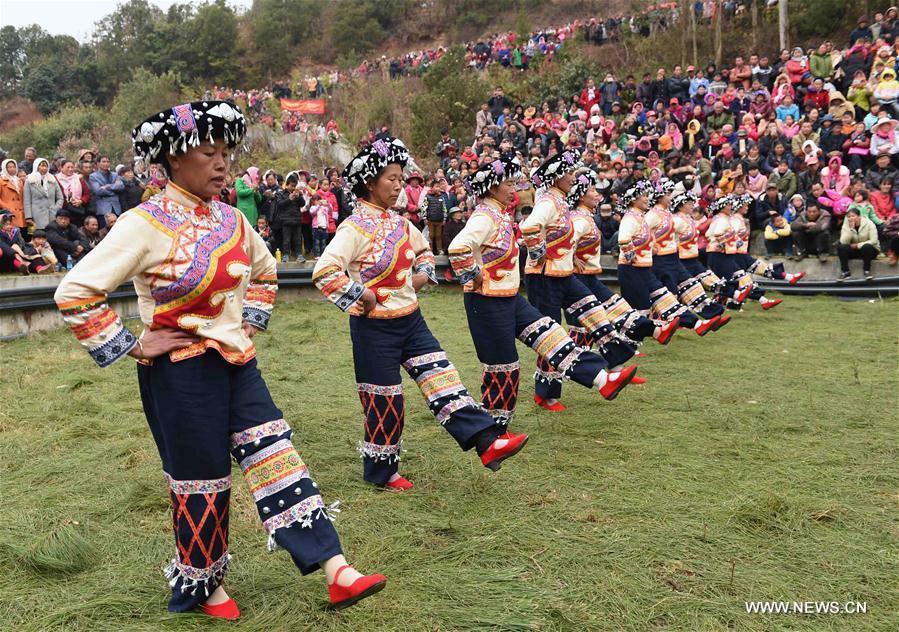People perform dragon dance in Nanchang, capital of east China's Jiangxi Province, Feb. 27, 2017. Er Yue Er fell on Feb. 27 this year. Chinese people call it the day when the "dragon raises its head", which means the spring awakens after winter hibernation. People usually have their hair cut or hold celebrations to greet the day. (Xinhua/Wan Xiang)
People perform dragon dance in Nanchang, capital of east China's Jiangxi Province, Feb. 27, 2017. Er Yue Er fell on Feb. 27 this year. Chinese people call it the day when the "dragon raises its head", which means the spring awakens after winter hibernation. People usually have their hair cut or hold celebrations to greet the day. (Xinhua/Wan Xiang)
People perform lion dance in Nanchang, capital of east China's Jiangxi Province, Feb. 27, 2017. Er Yue Er fell on Feb. 27 this year. Chinese people call it the day when the "dragon raises its head", which means the spring awakens after winter hibernation. People usually have their hair cut or hold celebrations to greet the day. (Xinhua/Wan Xiang)
People perform dragon dance in Nanchang, capital of east China's Jiangxi Province, Feb. 27, 2017. Er Yue Er fell on Feb. 27 this year. Chinese people call it the day when the "dragon raises its head", which means the spring awakens after winter hibernation. People usually have their hair cut or hold celebrations to greet the day. (Xinhua/Wan Xiang)
People perform lion dance in Nanchang, capital of east China's Jiangxi Province, Feb. 27, 2017. Er Yue Er fell on Feb. 27 this year. Chinese people call it the day when the "dragon raises its head", which means the spring awakens after winter hibernation. People usually have their hair cut or hold celebrations to greet the day. (Xinhua/Wan Xiang)
Tourists go sightseeing by ship at Longting scenic spot during a folk custom festival to celebrate Er Yue Er, or the second day of the second month on the Chinese Lunar calendar in Kaifeng, central China's Henan Province, Feb. 27, 2017. Er Yue Er fell on Feb. 27 this year. Chinese people call it the day when the "dragon raises its head", which means the spring awakens after winter hibernation. People usually have their hair cut or hold celebrations to greet the day. (Xinhua/Li Bo)
Tourists go sightseeing at Longting scenic spot during a folk custom festival to celebrate Er Yue Er, or the second day of the second month on the Chinese Lunar calendar in Kaifeng, central China's Henan Province, Feb. 27, 2017. Er Yue Er fell on Feb. 27 this year. Chinese people call it the day when the "dragon raises its head", which means the spring awakens after winter hibernation. People usually have their hair cut or hold celebrations to greet the day. (Xinhua/Li Bo)
Tourists go sightseeing at Longting scenic spot during a folk custom festival to celebrate Er Yue Er, or the second day of the second month on the Chinese Lunar calendar in Kaifeng, central China's Henan Province, Feb. 27, 2017. Er Yue Er fell on Feb. 27 this year. Chinese people call it the day when the "dragon raises its head", which means the spring awakens after winter hibernation. People usually have their hair cut or hold celebrations to greet the day. (Xinhua/Li Bo)
People perform dragon dance at Longting scenic spot during a folk custom festival to celebrate Er Yue Er, or the second day of the second month on the Chinese Lunar calendar in Kaifeng, central China's Henan Province, Feb. 27, 2017. Er Yue Er fell on Feb. 27 this year. Chinese people call it the day when the "dragon raises its head", which means the spring awakens after winter hibernation. People usually have their hair cut or hold celebrations to greet the day. (Xinhua/Li Bo)
People perform folklore performances to celebrate Er Yue Er, or the second day of the second month on the Chinese Lunar calendar in Hefei, Anhui province, Feb. 27, 2017. Er Yue Er fell on Feb. 27 this year. Chinese people call it the day when the "dragon raises its head", which means the spring awakens after winter hibernation. People usually have their hair cut or hold celebrations to greet the day. (Xinhua/Zhang Duan)
People perform folklore performances to celebrate Er Yue Er, or the second day of the second month on the Chinese Lunar calendar in Hefei, Anhui province, Feb. 27, 2017. Er Yue Er fell on Feb. 27 this year. Chinese people call it the day when the "dragon raises its head", which means the spring awakens after winter hibernation. People usually have their hair cut or hold celebrations to greet the day. (Xinhua/Zhang Duan)
People perform Jiangzhou drum music to celebrate Er Yue Er, or the second day of the second month on the Chinese Lunar calendar in Xinjiang County, Shanxi province , Feb. 27, 2017. Er Yue Er fell on Feb. 27 this year. Chinese people call it the day when the "dragon raises its head", which means the spring awakens after winter hibernation. People usually have their hair cut or hold celebrations to greet the day. (Xinhua/Zhan Yan)
People perform Jiangzhou drum music to celebrate Er Yue Er, or the second day of the second month on the Chinese Lunar calendar in Xinjiang County, Shanxi province , Feb. 27, 2017. Er Yue Er fell on Feb. 27 this year. Chinese people call it the day when the "dragon raises its head", which means the spring awakens after winter hibernation. People usually have their hair cut or hold celebrations to greet the day. (Xinhua/Zhan Yan)
People perform Jiangzhou drum music to celebrate Er Yue Er, or the second day of the second month on the Chinese Lunar calendar in Xinjiang County, Shanxi province , Feb. 27, 2017. Er Yue Er fell on Feb. 27 this year. Chinese people call it the day when the "dragon raises its head", which means the spring awakens after winter hibernation. People usually have their hair cut or hold celebrations to greet the day. (Xinhua/Zhan Yan)
People cut hair to celebrate Er Yue Er, or the second day of the second month on the Chinese Lunar calendar in Harbin, Heilongjiang province , Feb. 27, 2017. Er Yue Er fell on Feb. 27 this year. Chinese people call it the day when the "dragon raises its head", which means the spring awakens after winter hibernation. People usually have their hair cut or hold celebrations to greet the day. (Xinhua/Wang Jianwei)
People perform dragon dance to celebrate Er Yue Er, or the second day of the second month on the Chinese Lunar calendar in Harbin, Heilongjiang province , Feb. 27, 2017. Er Yue Er fell on Feb. 27 this year. Chinese people call it the day when the "dragon raises its head", which means the spring awakens after winter hibernation. People usually have their hair cut or hold celebrations to greet the day. (Xinhua/Wang Jianwei)
People perform dragon dance to celebrate Er Yue Er, or the second day of the second month on the Chinese Lunar calendar in Harbin, Heilongjiang province , Feb. 27, 2017. Er Yue Er fell on Feb. 27 this year. Chinese people call it the day when the "dragon raises its head", which means the spring awakens after winter hibernation. People usually have their hair cut or hold celebrations to greet the day. (Xinhua/Wang Jianwei)
People “burn fire dragon” to celebrate Er Yue Er, or the second day of the second month on the Chinese Lunar calendar in Huanglongxi Ancient Town, Chengdu, Sichuan province Feb. 26, 2017. Er Yue Er fell on Feb. 27 this year. Chinese people call it the day when the "dragon raises its head", which means the spring awakens after winter hibernation. People usually have their hair cut or hold celebrations to greet the day. (Xinhua/Jiang Hongjing)
People “burn fire dragon” to celebrate Er Yue Er, or the second day of the second month on the Chinese Lunar calendar in Huanglongxi Ancient Town, Chengdu, Sichuan province Feb. 26, 2017. Er Yue Er fell on Feb. 27 this year. Chinese people call it the day when the "dragon raises its head", which means the spring awakens after winter hibernation. People usually have their hair cut or hold celebrations to greet the day. (Xinhua/Jiang Hongjing)
People “burn fire dragon” to celebrate Er Yue Er, or the second day of the second month on the Chinese Lunar calendar in Huanglongxi Ancient Town, Chengdu, Sichuan province Feb. 26, 2017. Er Yue Er fell on Feb. 27 this year. Chinese people call it the day when the "dragon raises its head", which means the spring awakens after winter hibernation. People usually have their hair cut or hold celebrations to greet the day. (Xinhua/Jiang Hongjing)
Citizens and tourists celebrate Er Yue Er, or the second day of the second month on the Chinese Lunar calendar in Sanya, Hainan province Feb. 27, 2017. Er Yue Er fell on Feb. 27 this year. Chinese people call it the day when the "dragon raises its head", which means the spring awakens after winter hibernation. People usually have their hair cut or hold celebrations to greet the day. (Xinhua/Luo Yunfei)
Citizens and tourists celebrate Er Yue Er, or the second day of the second month on the Chinese Lunar calendar in Sanya, Hainan province Feb. 27, 2017. Er Yue Er fell on Feb. 27 this year. Chinese people call it the day when the "dragon raises its head", which means the spring awakens after winter hibernation. People usually have their hair cut or hold celebrations to greet the day. (Xinhua/Luo Yunfei)
Citizens and tourists celebrate Er Yue Er, or the second day of the second month on the Chinese Lunar calendar in Sanya, Hainan province Feb. 27, 2017. Er Yue Er fell on Feb. 27 this year. Chinese people call it the day when the "dragon raises its head", which means the spring awakens after winter hibernation. People usually have their hair cut or hold celebrations to greet the day. (Xinhua/Luo Yunfei)
Citizens and tourists celebrate Er Yue Er, or the second day of the second month on the Chinese Lunar calendar in Sanya, Hainan province Feb. 27, 2017. Er Yue Er fell on Feb. 27 this year. Chinese people call it the day when the "dragon raises its head", which means the spring awakens after winter hibernation. People usually have their hair cut or hold celebrations to greet the day. (Xinhua/Luo Yunfei)
Citizens and tourists celebrate Er Yue Er, or the second day of the second month on the Chinese Lunar calendar in Sanya, Hainan province Feb. 27, 2017. Er Yue Er fell on Feb. 27 this year. Chinese people call it the day when the "dragon raises its head", which means the spring awakens after winter hibernation. People usually have their hair cut or hold celebrations to greet the day. (Xinhua/Luo Yunfei)
People perform dragon dance to celebrate Er Yue Er, or the second day of the second month on the Chinese Lunar calendar in Bozhou city, Anhui province, Feb. 27, 2017. Er Yue Er fell on Feb. 27 this year. Chinese people call it the day when the "dragon raises its head", which means the spring awakens after winter hibernation. People usually have their hair cut or hold celebrations to greet the day. (Xinhua/Zhang Yanlin)
People perform dragon dance to celebrate Er Yue Er, or the second day of the second month on the Chinese Lunar calendar in Bozhou city, Anhui province, Feb. 27, 2017. Er Yue Er fell on Feb. 27 this year. Chinese people call it the day when the "dragon raises its head", which means the spring awakens after winter hibernation. People usually have their hair cut or hold celebrations to greet the day. (Xinhua/Zhang Yanlin)
People perform dragon dance to celebrate Er Yue Er, or the second day of the second month on the Chinese Lunar calendar in Bozhou city, Anhui province, Feb. 27, 2017. Er Yue Er fell on Feb. 27 this year. Chinese people call it the day when the "dragon raises its head", which means the spring awakens after winter hibernation. People usually have their hair cut or hold celebrations to greet the day. (Xinhua/Zhang Yanlin)
People perform dragon dance to celebrate Er Yue Er, or the second day of the second month on the Chinese Lunar calendar in Bozhou city, Anhui province, Feb. 27, 2017. Er Yue Er fell on Feb. 27 this year. Chinese people call it the day when the "dragon raises its head", which means the spring awakens after winter hibernation. People usually have their hair cut or hold celebrations to greet the day. (Xinhua/Zhang Yanlin)
People perform dragon dance to celebrate Er Yue Er, or the second day of the second month on the Chinese Lunar calendar in Bozhou city, Anhui province, Feb. 27, 2017. Er Yue Er fell on Feb. 27 this year. Chinese people call it the day when the "dragon raises its head", which means the spring awakens after winter hibernation. People usually have their hair cut or hold celebrations to greet the day. (Xinhua/Zhang Yanlin)
People hold a spring ploughing ceremony to celebrate Er Yue Er, or the second day of the second month on the Chinese Lunar calendar in Laibin city, Guangxi province, Feb. 27, 2017. Er Yue Er fell on Feb. 27 this year. Chinese people call it the day when the "dragon raises its head", which means the spring awakens after winter hibernation. People usually have their hair cut or hold celebrations to greet the day. (Xinhua/Fan Shaoguang)
People perform dragon dance in rape flower field to celebrate Er Yue Er, or the second day of the second month on the Chinese Lunar calendar in Qianjiang city, Hubei province on Feb. 27, 2017. Er Yue Er fell on Feb. 27 this year. Chinese people call it the day when the "dragon raises its head", which means the spring awakens after winter hibernation. People usually have their hair cut or hold celebrations to greet the day. (Xinhua/Wu Yanjun)
Students piece together their calligraphy works of Chinese character dragon to make a big one in Zibo City, Shandong province on Feb. 27, 2017. Er Yue Er fell on Feb. 27 this year. Chinese people call it the day when the "dragon raises its head", which means the spring awakens after winter hibernation. People usually have their hair cut or hold celebrations to greet the day. (Xinhua/Zhao Dongshan)
A man gets ready to fly a dragon head kite in Yantai city, Shandong province on Feb. 27, 2017. Er Yue Er fell on Feb. 27 this year. Chinese people call it the day when the "dragon raises its head", which means the spring awakens after winter hibernation. People usually have their hair cut or hold celebrations to greet the day. (Xinhua/Chu Yang)
People hold a goat fighting competition in Suzhou city, Anhui province on Feb. 27, 2017. Er Yue Er fell on Feb. 27 this year. Chinese people call it the day when the "dragon raises its head", which means the spring awakens after winter hibernation. People usually have their hair cut or hold celebrations to greet the day. (Xinhua/Cui Meng)
Students learn from their teacher to draw grain bin in Liaocheng City, Shandong province on Feb. 27, 2017. Er Yue Er fell on Feb. 27 this year. Chinese people call it the day when the "dragon raises its head", which means the spring awakens after winter hibernation. People usually have their hair cut or hold celebrations to greet the day. (Xinhua/Zhang Zhenxiang)
A teacher draws a red dot on the forehead of a student in Linyi City of Shandong Province on Feb. 27, 2017. Er Yue Er fell on Feb. 27 this year. Chinese people call it the day when the "dragon raises its head", which means the spring awakens after winter hibernation. People usually have their hair cut or hold celebrations to greet the day. (Xinhua/Wang Yanbing)
People hold a ceremony to celebrate Er Yue Er in a museum in Jilin City, Jilin province on Feb. 27, 2017. Er Yue Er fell on Feb. 27 this year. Chinese people call it the day when the "dragon raises its head", which means the spring awakens after winter hibernation. People usually have their hair cut or hold celebrations to greet the day. (Xinhua/Wang Mingming)
People of Yi ethnic group perform to celebrate Er Yue Er, or the second day of the second month on the Chinese Lunar calendar in Zika Village of Malong County, southwest China's Yunnan Province, Feb. 27, 2017. Er Yue Er fell on Feb. 27 this year. Chinese people call it the day when the "dragon raises its head", which means the spring awakens after winter hibernation. (Xinhua/Yang Zongyou)
Villagers take photos during a gathering to celebrate Er Yue Er, or the second day of the second month on the Chinese Lunar calendar in Zika Village of Malong County, southwest China's Yunnan Province, Feb. 27, 2017. Er Yue Er fell on Feb. 27 this year. Chinese people call it the day when the "dragon raises its head", which means the spring awakens after winter hibernation. (Xinhua/Yang Zongyou)
People of Yi ethnic group perform to celebrate Er Yue Er, or the second day of the second month on the Chinese Lunar calendar in Zika Village of Malong County, southwest China's Yunnan Province, Feb. 27, 2017. Er Yue Er fell on Feb. 27 this year. Chinese people call it the day when the "dragon raises its head", which means the spring awakens after winter hibernation. (Xinhua/Yang Zongyou)
People of Yi ethnic group perform to celebrate Er Yue Er, or the second day of the second month on the Chinese Lunar calendar in Zika Village of Malong County, southwest China's Yunnan Province, Feb. 27, 2017. Er Yue Er fell on Feb. 27 this year. Chinese people call it the day when the "dragon raises its head", which means the spring awakens after winter hibernation. (Xinhua/Yang Zongyou)
People of Yi ethnic group perform to celebrate Er Yue Er, or the second day of the second month on the Chinese Lunar calendar in Zika Village of Malong County, southwest China's Yunnan Province, Feb. 27, 2017. Er Yue Er fell on Feb. 27 this year. Chinese people call it the day when the "dragon raises its head", which means the spring awakens after winter hibernation. (Xinhua/Yang Zongyou)
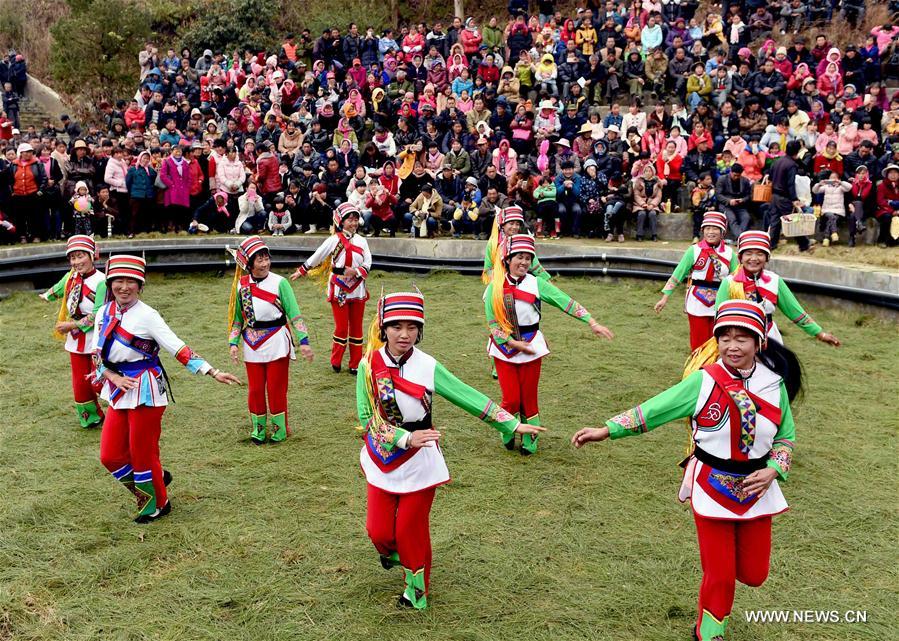
People of Yi ethnic group perform to celebrate Er Yue Er, or the second day of the second month on the Chinese Lunar calendar in Zika Village of Malong County, southwest China's Yunnan Province, Feb. 27, 2017. Er Yue Er fell on Feb. 27 this year. Chinese people call it the day when the "dragon raises its head", which means the spring awakens after winter hibernation. (Xinhua/Yang Zongyou)


















